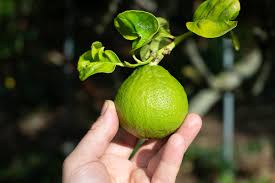








Bergamot- Citrus bergamia
Family - Rutaceae
Synonyms: Citrus aurantium sub. bergamia
General Description
A small tree, about 4.5 metres high with smooth oval leaves, bearing small round fruit which ripen from green to yellow, much like a miniature orange in appearance.
Distribution
native to tropical Asia. Extensively cultivated in Calabria in southern Italy and also grown commercially on the Ivory Coast.
Other Species
Not to be confused with the herb bergamot or bee balm (Monarda didyma).
Herbal/Folk Tradition
named after the Italian city of Bergamot in Lombardy, where the oil was first sold. The oil has been used in Italian folk medicine for many years, primarily for fever (including malaria) and worms; it does not feature in the folk tradition of any other countries.
However, due to recent research in Italy, bergamot oil is now known to have a wide spectrum of applications, being particularly useful for mouth, skin, respiratory and urinary tract infections.
Actions
Analgesic, anthelmintic, antidepressant, antiseptic (pulmonary, genito-urinary), antispasmodic, antitoxic, carminative, digestive, diuretic, deodorant, febrifuge, laxative, parasiticide, rubefacient, stimulant, stomachic, tonic, vermifuge, vulnerary.
Extraction
Essential oil by cold expression of the peel of the nearly ripe fruit. (A rectified or terpeneless oil is produced by vacuum distillation or solvent extraction.)
Characteristics
A light greenish-yellow liquid with a fresh sweet-fruity, slightly spicy balsamic undertone. On ageing it turns a brownish-olive colour. It blends well with lavender, neroli, jasmine, coriander and violet.
Principal Constituents
Known to have about 300 compounds present in the expressed oil: mainly linalyl acetate (30-60 per cent), linalol (11-22 per cent) and other alcohols, sesquiterpenes, terpenes, alkanes and furocoumarins (including bergapten. 0.30-0.39 per cent).
Safety Data
Certain furocoumarins, notably begapten, have been found to be phototoxic on human skin, that is, they cause sensitization and skin pigmentation when exposed to direct sunlight (in concentration and in dilution even after using the oil in dermal applications-otherwise a rectified or @bergapten-free' oil should be substituted.
Available information indicates it to be otherwise non-toxic and relatively non-irritant.
Aromatherapy/Home Use
Skin care
Acne, boils, cold sores, eczema, insect repellent and insect bites, oily complexion, psoriasis, scabies, spots, varicose ulcers, wounds.
Respiratory system
Halitosis, mouth infections, sore throat, tonsillitis.
Digestive system
Flatulence, loss of appetite
Genito-urinary system
Cystitis, leucorrhoea, pruritis, thrush.
Immune system
Colds, fever, 'flu, infectious diseases.
Nervous system
Anxiety, depression and stress-related conditions, having a refreshing and uplifting quality.
Other Uses
Extensively used as a fragrance and, to a degree, a fixative in cosmetics, toiletries, suntan lotions and perfumes - it is a classic ingredient of eau-de-cologne. Widely used in most major food categories and beverages, notably Earl grey tea.
Reference: The Encyclopedia of Essential Oils: Julia Lawless
Articles Latest
- CARDAMON
- CARAWAY
- CANANGA
- CAMPHOR
- CALAMUS
- Calamintha-Calamintha officinalis
- CAJEPUT- Melaleuca cajeputi
- Plant Expression
- Molecular Target: Cell Membrane
- CADE Essential Oil
- CABREUVA
- The Kashmiri rose oil worth millions
- Agarwood: The natural treasure worth more than gold whose heady scent is driving it towards extinction
- Nonselective Binding to Proteins: The Science of Advanced Aromatherapy
- Molecular Target: DNA, RNA, and Gene Expression
- BUCHU - Agothosma betulina
- BROOM - SPANISH - spartium junceum
- BORONiA - Boronia megastigma
- BORNEOL - Dryobalanops aromantica
- Boldo Leaf - Peumus boldus
- Birch White-Betula Alba
Articles-Most Read
- Home
- Balsam Canadian - Abies balsamea
- Copaiba Essential Oil
- Balsam Peru
- Basil French - Ocimum basilicum
- North America: Tea Tree and Monarda-3
- Basil Exotic
- North America: Tea Tree and Monarda-2
- Exploring Transcultural Constants
- Thyme Essential Oil
- Balsam Tolu
- Palma Rosa
- The Bioactivity of Essential Oils
- Benzoin - Styrax benzoin
- Why Pharmacology Cannot Demonstrate Essential Oil Efficacy
- Bay - West Indian - Pimenta racemosa
- Exploring Essential Oil Activity The Conventional Way
- Aromatherapy: An Answer
- Complex information From Plants
- Contacts
